I love me some comets.
I’ve seen quite a few in my time. Some were faint smudges in a big telescope’s eyepiece, some seen only in distant spacecraft images, and some so bright they were obvious and awesome to my naked eye.
They used to be considered harbingers, omens up for interpretation by mystics and people looking for reasons things happened the way they do. In reality, comets are just a class of objects in our solar system along with planets, asteroids, dust, and one biggish star.
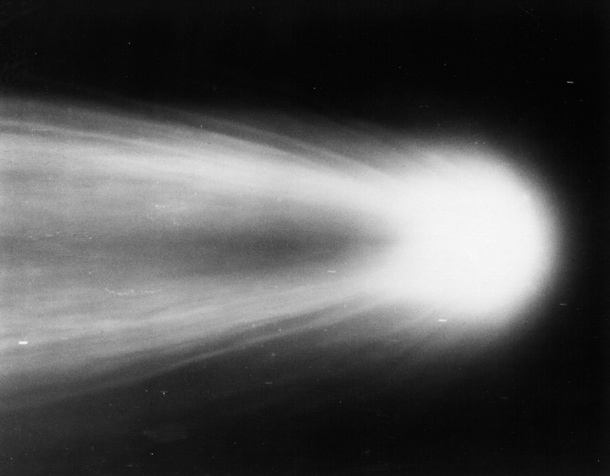 Hmm. Did I say “just”? That’s unfair. They are gorgeous, interesting objects, worthy of study. And 100 years ago today—April 20, 1910—we got a pretty good look at the most famous of them all, Comet Halley, as it passed the Earth at a distance of just 23 million km (14 million miles). It got so bright that it was obvious even when seen from cities. As geometry would have it, the Earth even passed through the comet’s tail, sparking fears of widespread death (cyanogen was detected in the comet, making people think it would poison them). It was the talk of the planet, featured in magazines and papers across the globe. For your history enjoyment, here is one of those articles from the 1910, transcribed by James Brooks. It gives a great flavor of the times.
To celebrate this remarkable centennial anniversary, I have put together Ten Things You Don’t Know About Comets. I imagine some readers will know some of these, and some will know all ten, but if you do you can still enjoy the pretty pictures – and make sure you click on them to embiggen ‘em. And if you like this, I have several others, too (Ten Things You Don’t Know About… the Earth, Black Holes, Hubble, the Sun, Pluto, and the Milky Way), so check ‘em all out and see how many things you don’t know.
The actual solid part of a comet is tiny.
Hmm. Did I say “just”? That’s unfair. They are gorgeous, interesting objects, worthy of study. And 100 years ago today—April 20, 1910—we got a pretty good look at the most famous of them all, Comet Halley, as it passed the Earth at a distance of just 23 million km (14 million miles). It got so bright that it was obvious even when seen from cities. As geometry would have it, the Earth even passed through the comet’s tail, sparking fears of widespread death (cyanogen was detected in the comet, making people think it would poison them). It was the talk of the planet, featured in magazines and papers across the globe. For your history enjoyment, here is one of those articles from the 1910, transcribed by James Brooks. It gives a great flavor of the times.
To celebrate this remarkable centennial anniversary, I have put together Ten Things You Don’t Know About Comets. I imagine some readers will know some of these, and some will know all ten, but if you do you can still enjoy the pretty pictures – and make sure you click on them to embiggen ‘em. And if you like this, I have several others, too (Ten Things You Don’t Know About… the Earth, Black Holes, Hubble, the Sun, Pluto, and the Milky Way), so check ‘em all out and see how many things you don’t know.
The actual solid part of a comet is tiny.
 When you see a picture of a comet it looks huge—and the part you’re seeing really is. The head of the comet—the big fuzzy ball at the front—can be hundreds of thousands of kilometers across, bigger than whole planets. But what you’re seeing is incredibly low-density gas warmed by the Sun, leaking out from the solid part of the comet called the nucleus. In general, the gas is thinner than a laboratory vacuum. It’s very good at reflecting sunlight, so it appears bright, but in reality it’s as ethereal and thin as a politician’s promise.
Amazingly, the solid nucleus of a comet is usually only a few kilometers across, far too small to see in images. The picture here is of Comet Holmes in 2007, taken by Tamas Ladanyi. While Holmes was on its way out, away from the Sun, there was a huge outburst probably caused by some gas leaking out of the nucleus. A vast cloud of gas expanded around it, and even though it was tens of millions of kilometers away from Earth, it was easily visible as a fuzzy patch in the sky. But the nucleus is so small that no telescope on Earth could’ve seen it as more than a tiny dot. In this picture, it is far smaller than the size of a pixel!
Comets are dirty snowballs.
When you see a picture of a comet it looks huge—and the part you’re seeing really is. The head of the comet—the big fuzzy ball at the front—can be hundreds of thousands of kilometers across, bigger than whole planets. But what you’re seeing is incredibly low-density gas warmed by the Sun, leaking out from the solid part of the comet called the nucleus. In general, the gas is thinner than a laboratory vacuum. It’s very good at reflecting sunlight, so it appears bright, but in reality it’s as ethereal and thin as a politician’s promise.
Amazingly, the solid nucleus of a comet is usually only a few kilometers across, far too small to see in images. The picture here is of Comet Holmes in 2007, taken by Tamas Ladanyi. While Holmes was on its way out, away from the Sun, there was a huge outburst probably caused by some gas leaking out of the nucleus. A vast cloud of gas expanded around it, and even though it was tens of millions of kilometers away from Earth, it was easily visible as a fuzzy patch in the sky. But the nucleus is so small that no telescope on Earth could’ve seen it as more than a tiny dot. In this picture, it is far smaller than the size of a pixel!
Comets are dirty snowballs.
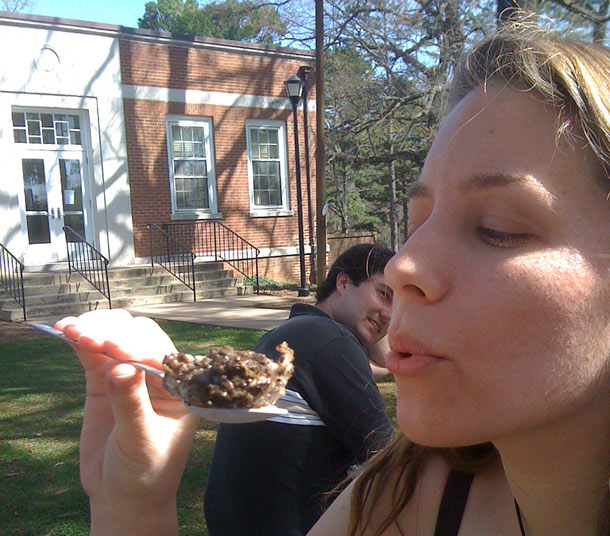 So what makes up the nucleus of a comet? That’s not simple to answer, because every comet is different, and there are things that straddle the line between comet and asteroid.
In general, comet nuclei are mountain-size dirty snowballs: rock, dust, gravel and other bits of stuff all mixed up with what I like to call “frozen gases”—I know, gas isn’t solid, but we’re talking ammonia, carbon dioxide, methane… stuff we usually think of as gases. Astronomers call them “ice”, but I want to distinguish them from water ice.
And there’s water. Lots and lots of water. It’s frozen solid, of course, until the comet gets near the Sun. Then these ices sublimate (turn from a solid directly into a gas), forming the giant head of the comet and also stream away to form the tail. When these gases are released we can study them with telescopes and determine what’s in them. In the 1980s, the Giotto spacecraft found that 80% of the material blown out from Comet Halley was water! That’s true of most comets studied, too.
The picture above shows my friend Gail Zasowski, an astronomy grad student at my alma mater, the University of Virginia. She and fellow grad student Nicole Gugliucci made comets for kids as part of the Dark Skies, Bright Kids program. They used dry ice, water, window cleaner, dirt, and other products to make model comets. In the picture, Gail is blowing on the “comet” to make it outgas. I’ve done this as well, and it’s a fun activity (though a wee bit dangerous since dry ice is so cold). You can find more pictures on Nicole’s Flickr page.
But that means…
Comets spend most of their lives looking pretty much like asteroids.
So what makes up the nucleus of a comet? That’s not simple to answer, because every comet is different, and there are things that straddle the line between comet and asteroid.
In general, comet nuclei are mountain-size dirty snowballs: rock, dust, gravel and other bits of stuff all mixed up with what I like to call “frozen gases”—I know, gas isn’t solid, but we’re talking ammonia, carbon dioxide, methane… stuff we usually think of as gases. Astronomers call them “ice”, but I want to distinguish them from water ice.
And there’s water. Lots and lots of water. It’s frozen solid, of course, until the comet gets near the Sun. Then these ices sublimate (turn from a solid directly into a gas), forming the giant head of the comet and also stream away to form the tail. When these gases are released we can study them with telescopes and determine what’s in them. In the 1980s, the Giotto spacecraft found that 80% of the material blown out from Comet Halley was water! That’s true of most comets studied, too.
The picture above shows my friend Gail Zasowski, an astronomy grad student at my alma mater, the University of Virginia. She and fellow grad student Nicole Gugliucci made comets for kids as part of the Dark Skies, Bright Kids program. They used dry ice, water, window cleaner, dirt, and other products to make model comets. In the picture, Gail is blowing on the “comet” to make it outgas. I’ve done this as well, and it’s a fun activity (though a wee bit dangerous since dry ice is so cold). You can find more pictures on Nicole’s Flickr page.
But that means…
Comets spend most of their lives looking pretty much like asteroids.
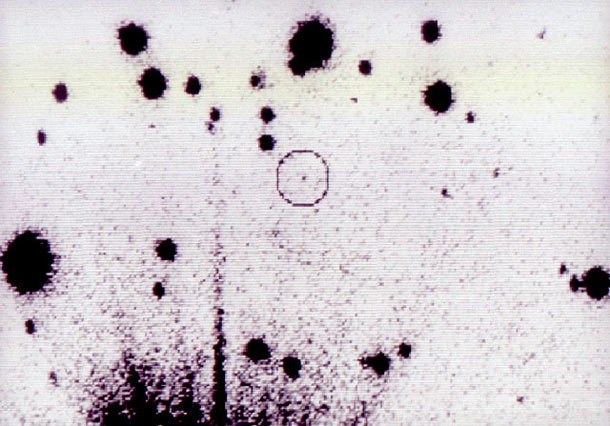 Comets tend to have long, elliptical orbits. The farther they are from the Sun, the slower they travel, so really they might spend 99.9 percent of their lives far, far from the heat of our nearest star. That in turn means that all that volatile stuff in the nucleus is frozen, and actually it gets so cold that even the water freezes into ice harder than rocks on Earth.
That image above is actually of Comet Halley! It was taken in 1982, about three years before passed us once again. It was out past the orbit of Saturn when the Palomar observatory took this image (it’s a negative, which helps our eyes seen faint objects). The comet is circled, and if it weren’t you’d never notice it. That far from the Sun, there’s no outgassing, no spectacular head or tail. Just a little dot, frozen hard as nails.
In fact, the difference between asteroids and comets may just be how much stuff is in them that doesn’t blow away when they get near the Sun. After all, if we see a rock with just a little bit of gas coming out of it, is it an asteroid or a comet? In fact, many asteroids are in comet-like orbits; maybe some had their orbits affected by Jupiter, or maybe they are simply burned out comets.
Every time a comet comes near the Sun, it dies a little bit.
Comets tend to have long, elliptical orbits. The farther they are from the Sun, the slower they travel, so really they might spend 99.9 percent of their lives far, far from the heat of our nearest star. That in turn means that all that volatile stuff in the nucleus is frozen, and actually it gets so cold that even the water freezes into ice harder than rocks on Earth.
That image above is actually of Comet Halley! It was taken in 1982, about three years before passed us once again. It was out past the orbit of Saturn when the Palomar observatory took this image (it’s a negative, which helps our eyes seen faint objects). The comet is circled, and if it weren’t you’d never notice it. That far from the Sun, there’s no outgassing, no spectacular head or tail. Just a little dot, frozen hard as nails.
In fact, the difference between asteroids and comets may just be how much stuff is in them that doesn’t blow away when they get near the Sun. After all, if we see a rock with just a little bit of gas coming out of it, is it an asteroid or a comet? In fact, many asteroids are in comet-like orbits; maybe some had their orbits affected by Jupiter, or maybe they are simply burned out comets.
Every time a comet comes near the Sun, it dies a little bit.
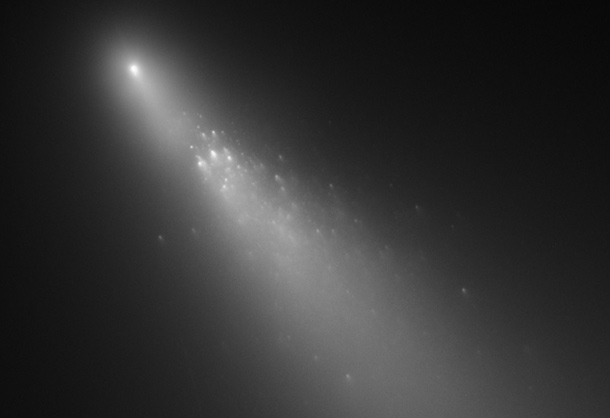 Like many things in life and the Universe, what makes a comet beautiful will eventually kill it. Well, kill it as a comet.
Some comets are held together by the frozen gases. As one of these passes the Sun, that gas blows away, and the comet loses some of its structural integrity. Eventually, if it’s mostly gas, it’ll disintegrate. We’ve seen comets do this! They fall apart as they near the Sun (FYI it’s called calving when a big piece breaks off, but disintegrating completely would be a catastrophic calving, I suppose) – like the one shown above, a Hubble image of comet 73P/Schwassmann-Wachmann 3 when it fell apart in 2006. Even comets that are mostly rock with only some gas can be weakened by losing that gas, because they would be left with large empty pockets inside the rock. If something like that got too close to Jupiter, say, the gravity of the planet (really, the tides) might tear the comet to shreds. Shoemaker-Levy 9 was a comet that broke into dozens of pieces and slammed into Jupiter in 1994. It may have been such a weakened comet that couldn’t survive Jupiter’s ferocious gravity.
Comets lose a lot of mass when they go by the Sun. A lot: some shed hundreds of tons of material per second. That’s actually a small fraction of the mass of a comet, but given time, and lots of solar passes, it adds up. Every comet we see is slowly dissolving in space. Eventually even the mighty Comet Halley will be gone, broken down into a swarm of rocks, gravel, and dust once its gas is gone.
But there will always be more to replace it.
Comets can have two tails
Like many things in life and the Universe, what makes a comet beautiful will eventually kill it. Well, kill it as a comet.
Some comets are held together by the frozen gases. As one of these passes the Sun, that gas blows away, and the comet loses some of its structural integrity. Eventually, if it’s mostly gas, it’ll disintegrate. We’ve seen comets do this! They fall apart as they near the Sun (FYI it’s called calving when a big piece breaks off, but disintegrating completely would be a catastrophic calving, I suppose) – like the one shown above, a Hubble image of comet 73P/Schwassmann-Wachmann 3 when it fell apart in 2006. Even comets that are mostly rock with only some gas can be weakened by losing that gas, because they would be left with large empty pockets inside the rock. If something like that got too close to Jupiter, say, the gravity of the planet (really, the tides) might tear the comet to shreds. Shoemaker-Levy 9 was a comet that broke into dozens of pieces and slammed into Jupiter in 1994. It may have been such a weakened comet that couldn’t survive Jupiter’s ferocious gravity.
Comets lose a lot of mass when they go by the Sun. A lot: some shed hundreds of tons of material per second. That’s actually a small fraction of the mass of a comet, but given time, and lots of solar passes, it adds up. Every comet we see is slowly dissolving in space. Eventually even the mighty Comet Halley will be gone, broken down into a swarm of rocks, gravel, and dust once its gas is gone.
But there will always be more to replace it.
Comets can have two tails
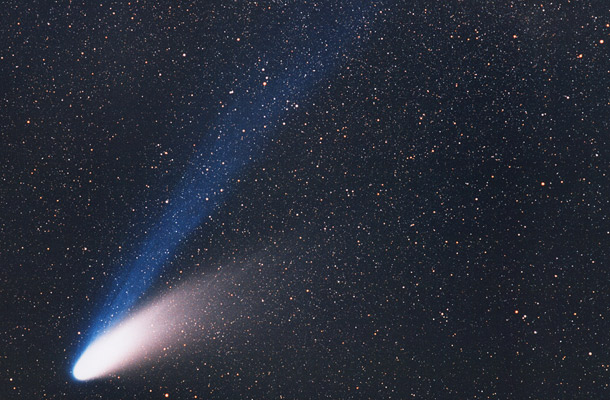 I’ve been talking about the tail of a comet, but actually they can have more than one! It’s common to see two tails from a comet, like in the picture above of Comet Hale-Bopp. As gas sublimates from the head of the comet, the solar wind—a stream of charged particles streaming off the Sun – can blow it back. The solar wind is very high velocity, much faster than a comet moves, so that tail blows straight off the comet. The gases get ionized by the wind; that is, the electrons in their atoms get stripped off. The ions are then affected strongly by the magnetic field of the solar wind, which sweeps them up and drags them along. The blue color of this ion tail is due to carbon monoxide.
I’ve been talking about the tail of a comet, but actually they can have more than one! It’s common to see two tails from a comet, like in the picture above of Comet Hale-Bopp. As gas sublimates from the head of the comet, the solar wind—a stream of charged particles streaming off the Sun – can blow it back. The solar wind is very high velocity, much faster than a comet moves, so that tail blows straight off the comet. The gases get ionized by the wind; that is, the electrons in their atoms get stripped off. The ions are then affected strongly by the magnetic field of the solar wind, which sweeps them up and drags them along. The blue color of this ion tail is due to carbon monoxide. which scatters blue light toward us (similar to why the sky is blue). As electrons recombine with the ions they give off light, causing the tail to glow predominantly blue (though other colors are present due to other elements and molecules as well).
Mixed in with the gas blowing off the comet is also dust: ground up silicates, minerals, and other more stable substances. This material is denser and not as subject to the solar wind. It has a yellowish or reddish color because it reflects sunlight. This tail can curve, following the comet’s path itself. In many pictures of comets, you can see the blue ion tail screaming straight out from the comet head, while the yellower dust tail gently curves, sometimes for millions of kilometers.
In reality, comets can have lots of tails. The dust tail can be broken up into several straight features called dust striae, the cause of which is unknown but most likely due to large (well, boulder-sized) pieces of the comet breaking off and forming their own tails. Some comets have sported as many as a half-dozen tails!
Comets spawn meteor showers
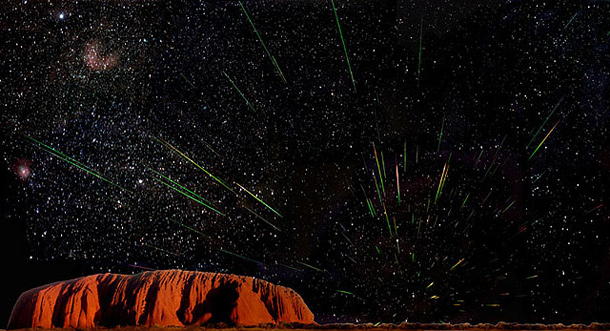 So we have millions of tons of material blowing off a comet every time it passes the Sun. What happens to that junk?
There’s very little force acting on this material, so it continues to orbit the Sun in very much the same orbit as the comet itself. That stuff can happily circle (ellipse? Ellipticate?) the Sun for hundreds of millennia, but not always. Sometimes the comet’s orbit intersects the Earth (more on that not-quite-so-happy circumstance in a moment), which means the Earth can plow through this debris. Normally, the Earth hits about 100 tons of space detritus a day, but that number can jump substantially when it rams a comet’s orbit. This material burns up in our atmosphere, and we get a meteor shower.
That’s right: when you go out and observe the Perseids, the Leonids, the Geminids, the Taurids, you are seeing the dandruff from a comet (which is an appropriate metaphor, since coma means “hair” in Latin). Even a snowflake can put on quite a show when it slams into our atmosphere at 100 km/sec. That kinetic energy is converted into heat and light, and is visible as a shooting star for hundreds of kilometers. Sometimes you get a small chunk of gravel, too, and that becomes an intense fireball, bright enough to leave an afterimage on your eye (I’ve seen a few, and they’re heart-stopping).
This also means that meteor showers are associated with specific comets. Halley’s has two: the Orionids in October and the Eta Aquarids in May. The August Perseid shower is due to litter from the comet Swift-Tuttle, and the November Leonids are from the comet Tempel-Tuttle. They happen at the same time every year because that’s when the Earth is at the intersection of the two orbits. The spectacular image above is from the 2001 Leonids, seen in Australia by Jen and Vic Winters of ICStars.
I’ll add the orbits of the debris do get pushed around a bit. Solar wind, light pressure from the Sun, gravity of the planets: these can affect the debris, changing when and where the Earth hits them, so over time the meteor showers evolve. Also, if the parent comet made a recent passage, the debris cloud can be thicker, and when the Earth rams into it we get a meteor storm. The Leonids of the late 1990s produced many such intense storms, with rates as high as thousands of meteors per hour!
Comets are potentially more dangerous than asteroids
So we have millions of tons of material blowing off a comet every time it passes the Sun. What happens to that junk?
There’s very little force acting on this material, so it continues to orbit the Sun in very much the same orbit as the comet itself. That stuff can happily circle (ellipse? Ellipticate?) the Sun for hundreds of millennia, but not always. Sometimes the comet’s orbit intersects the Earth (more on that not-quite-so-happy circumstance in a moment), which means the Earth can plow through this debris. Normally, the Earth hits about 100 tons of space detritus a day, but that number can jump substantially when it rams a comet’s orbit. This material burns up in our atmosphere, and we get a meteor shower.
That’s right: when you go out and observe the Perseids, the Leonids, the Geminids, the Taurids, you are seeing the dandruff from a comet (which is an appropriate metaphor, since coma means “hair” in Latin). Even a snowflake can put on quite a show when it slams into our atmosphere at 100 km/sec. That kinetic energy is converted into heat and light, and is visible as a shooting star for hundreds of kilometers. Sometimes you get a small chunk of gravel, too, and that becomes an intense fireball, bright enough to leave an afterimage on your eye (I’ve seen a few, and they’re heart-stopping).
This also means that meteor showers are associated with specific comets. Halley’s has two: the Orionids in October and the Eta Aquarids in May. The August Perseid shower is due to litter from the comet Swift-Tuttle, and the November Leonids are from the comet Tempel-Tuttle. They happen at the same time every year because that’s when the Earth is at the intersection of the two orbits. The spectacular image above is from the 2001 Leonids, seen in Australia by Jen and Vic Winters of ICStars.
I’ll add the orbits of the debris do get pushed around a bit. Solar wind, light pressure from the Sun, gravity of the planets: these can affect the debris, changing when and where the Earth hits them, so over time the meteor showers evolve. Also, if the parent comet made a recent passage, the debris cloud can be thicker, and when the Earth rams into it we get a meteor storm. The Leonids of the late 1990s produced many such intense storms, with rates as high as thousands of meteors per hour!
Comets are potentially more dangerous than asteroids
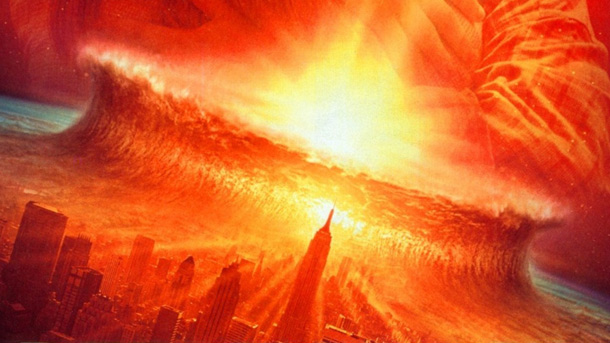 We’ve all seen the TV shows and movies about asteroid impacts. A giant rock 10 kilometers across hits us, causing tsunamis, giant mushroom-clouding fireballs, death, disaster, and an excuse for Bruce Willis to overact and Ben Affleck to cry.
But comets are in many ways more dangerous.
Even though comets are lower density than asteroids (ice versus rock), there are three factors that make them scarier when it comes to impacts:
1) They can come from deep, deep space, falling all the way from beyond Neptune’s orbit. They pick up a lot of velocity, and some can be moving at 70 km/sec (40 miles/sec) relative to the Earth if the geometry is right. Most asteroid impacts are in the 20 km/sec (12 miles/sec) range. That factor of 3.5 in speed translates into a factor of 10 in energy, so a comet with the same mass as an asteroid can generate an explosion ten times bigger. Yikes.
2) Potentially impacting comets can be much bigger than known potentially impacting asteroids. The largest known potentially hazardous asteroid is Toutatis, which is about 5 km (3 miles) wide. The nucleus of Hale-Bopp is about 60 km (35 miles) across, more than ten times bigger. That means it has hundreds of times the mass of Toutatis, and if it hit would create an explosion far, far more devastating than the one that wiped out the dinosaurs, as well as more than half of all species of life on Earth.
3) Comet orbits are hard to predict. Asteroids tend to stay on nice, measurable orbits, making them potentially predictable years in advance. Comets, though, emit gas that can act like rocket motors, pushing the nucleus this way and that. In some cases an impact may not be predictable until weeks before it happens. Worse, since comets are so dark and can come from any direction in the sky, many aren’t even discovered until they are practically on top of us. Hale-Bopp, one of the brightest comets seen in decades, was discovered a mere 19 months before it passed the Earth. Had it been on an impact trajectory, you wouldn’t be here reading this.
The good news, of course, is that these events are rare. The last big impact-related event was 65 million years ago. It’s unlikely we’ll get another one any time soon.
We’ve all seen the TV shows and movies about asteroid impacts. A giant rock 10 kilometers across hits us, causing tsunamis, giant mushroom-clouding fireballs, death, disaster, and an excuse for Bruce Willis to overact and Ben Affleck to cry.
But comets are in many ways more dangerous.
Even though comets are lower density than asteroids (ice versus rock), there are three factors that make them scarier when it comes to impacts:
1) They can come from deep, deep space, falling all the way from beyond Neptune’s orbit. They pick up a lot of velocity, and some can be moving at 70 km/sec (40 miles/sec) relative to the Earth if the geometry is right. Most asteroid impacts are in the 20 km/sec (12 miles/sec) range. That factor of 3.5 in speed translates into a factor of 10 in energy, so a comet with the same mass as an asteroid can generate an explosion ten times bigger. Yikes.
2) Potentially impacting comets can be much bigger than known potentially impacting asteroids. The largest known potentially hazardous asteroid is Toutatis, which is about 5 km (3 miles) wide. The nucleus of Hale-Bopp is about 60 km (35 miles) across, more than ten times bigger. That means it has hundreds of times the mass of Toutatis, and if it hit would create an explosion far, far more devastating than the one that wiped out the dinosaurs, as well as more than half of all species of life on Earth.
3) Comet orbits are hard to predict. Asteroids tend to stay on nice, measurable orbits, making them potentially predictable years in advance. Comets, though, emit gas that can act like rocket motors, pushing the nucleus this way and that. In some cases an impact may not be predictable until weeks before it happens. Worse, since comets are so dark and can come from any direction in the sky, many aren’t even discovered until they are practically on top of us. Hale-Bopp, one of the brightest comets seen in decades, was discovered a mere 19 months before it passed the Earth. Had it been on an impact trajectory, you wouldn’t be here reading this.
The good news, of course, is that these events are rare. The last big impact-related event was 65 million years ago. It’s unlikely we’ll get another one any time soon.
Seven Eight Nine comets have been visited by spacecraft. So far.
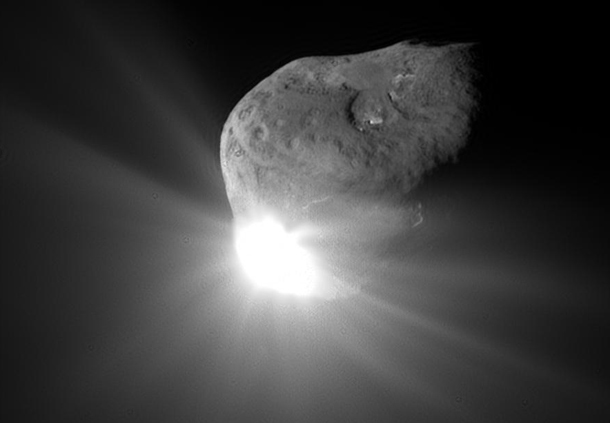 We’ve sent probes to every planet in our solar system (and one’s on its way to Pluto, so there’s that as well). Amazingly, our robotic proxies have visited as many comets as planets! Here’s a list of comets we’ve flung spacecraft at:
Comet 67P/Churyumov-Gerasimenko: Rosetta/Philae
Comet 19P/Borrelly: Deep Space 1
Comet 81P/Wild 2: Stardust
Comet McNaught: Ulysses, kinda, when it passed through the tail 160 million miles from core
Comet 21P/Giacobini-Zinner: ICE
Comet26P/Grigg-Skjellerup: Giotto
Comet Halley: Giotto, Vega 1 and 2, Sakigake, Suisei
Comet Tempel 1: Deep Impact and Stardust
Comet 103/P Hartley: EPOXI
Also, kinda sorta… Comet C/2013 A1 (Siding Spring): Various Mars spacecraft. I only include it here as incidental, since the missions weren’t to visit the comet; the comet went past them. After all, lots of spacecraft like Hubble and other observatories have seen comets, and it doesn’t make sense to include all of them. My thanks to Twitter user brx0 for pointing this out.
Most of the spacecraft flew past the comets, taking data as they went. But in 2005 we tried something a little different: the image above is from the Deep Impact mission to Comet Tempel 1. The spacecraft slammed a big block of copper into the comet’s 8 x 5 km (5 x 3 mile) nucleus to create a crater, exposing the material underneath for study. The 10 km/sec (6 miles/sec) collision blew a crater 100 meters across.
Update, Nov. 13, 2014: The European Space Agency mission Rosetta entered orbit around the comet 67P/Churyumov-Gerasimenko in August 2014, and in November of that year deployed the Philae lander onto the surface of the comet, the first time such a landing had ever been done. Also, in 2011, the Stardust mission flew past comet Tempel 1 to look at the damage Deep Impact had wrought (thabnks to reader Ian Regan for that). Also, I added comet C2013/A1 (Siding Spring) to the list.
Update, Jan. 20, 2014: EPOXI visited comet Hartley 2 in November 2010, a few months after this article was originally written, so I’ve updated this to include it.
The best comet hunter of all time is SOHO
We’ve sent probes to every planet in our solar system (and one’s on its way to Pluto, so there’s that as well). Amazingly, our robotic proxies have visited as many comets as planets! Here’s a list of comets we’ve flung spacecraft at:
Comet 67P/Churyumov-Gerasimenko: Rosetta/Philae
Comet 19P/Borrelly: Deep Space 1
Comet 81P/Wild 2: Stardust
Comet McNaught: Ulysses, kinda, when it passed through the tail 160 million miles from core
Comet 21P/Giacobini-Zinner: ICE
Comet26P/Grigg-Skjellerup: Giotto
Comet Halley: Giotto, Vega 1 and 2, Sakigake, Suisei
Comet Tempel 1: Deep Impact and Stardust
Comet 103/P Hartley: EPOXI
Also, kinda sorta… Comet C/2013 A1 (Siding Spring): Various Mars spacecraft. I only include it here as incidental, since the missions weren’t to visit the comet; the comet went past them. After all, lots of spacecraft like Hubble and other observatories have seen comets, and it doesn’t make sense to include all of them. My thanks to Twitter user brx0 for pointing this out.
Most of the spacecraft flew past the comets, taking data as they went. But in 2005 we tried something a little different: the image above is from the Deep Impact mission to Comet Tempel 1. The spacecraft slammed a big block of copper into the comet’s 8 x 5 km (5 x 3 mile) nucleus to create a crater, exposing the material underneath for study. The 10 km/sec (6 miles/sec) collision blew a crater 100 meters across.
Update, Nov. 13, 2014: The European Space Agency mission Rosetta entered orbit around the comet 67P/Churyumov-Gerasimenko in August 2014, and in November of that year deployed the Philae lander onto the surface of the comet, the first time such a landing had ever been done. Also, in 2011, the Stardust mission flew past comet Tempel 1 to look at the damage Deep Impact had wrought (thabnks to reader Ian Regan for that). Also, I added comet C2013/A1 (Siding Spring) to the list.
Update, Jan. 20, 2014: EPOXI visited comet Hartley 2 in November 2010, a few months after this article was originally written, so I’ve updated this to include it.
The best comet hunter of all time is SOHO
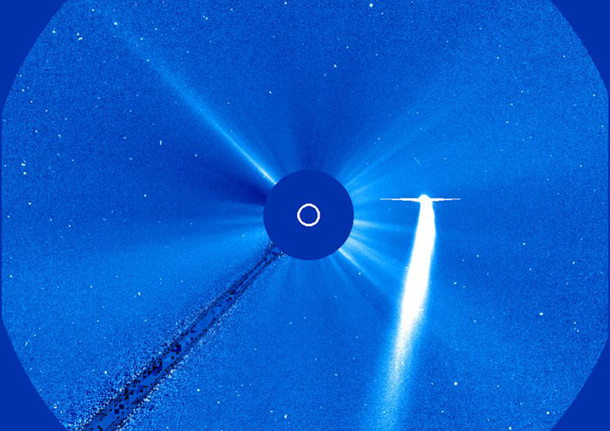 For hundreds of years, comets were spotted by astronomers either watching the skies by eye, or slowly scanning with a telescope. But a couple of decades ago, the robot uprising started. Automated telescopes were able to scan faster than humans, and detect fainter objects. It became rarer and rarer for amateur astronomers to spot comets before the surveys did.
But even those ground-based robots lag behind the all-time comet-spotting champ: The Solar and Heliospheric Observatory (SOHO). This space-based observatory sits in a gravitational sweet spot about 1.5 million km (1 million miles) from the Earth toward the Sun. In that location it can stare at the Sun 24 hours a day. It was placed there in 1995, so it’s had a long time to watch our nearest star.
And it’s seen a lot of comets as they plunge near or even into the Sun: to date, it’s spotted 1685 of them!
The picture above shows Comet Bradfield as it dipped past the Sun in 2004. SOHO uses a little metal disk to block the light from the Sun (the white circle represents the size of the Sun behind the disk), so fainter objects can be detected; you can see bright streamers erupting from the Sun, with flares and other solar hiccups common too. But this means it can spot comets as they make their death dive into the Sun which is why SOHO is so good at seeing them.
By the way, that horizontal line through the comet head is not real; it’s an artifact of the way the electronic detector used by SOHO records information; bright objects flood the camera with light, and the electrons generated overflow the pixels. You may not be surprised to find out some people claim this is evidence for UFOs and all other manners of nonsense, but if they bothered to ask a, y’know, scientist, they’d find out what’s real and what isn’t. Of course, most of them don’t care what’s real!
But those comets certainly are real, and the images and movies of them diving into the Sun are fascinating and beautiful to watch.
Some comets can be seen in daylight
For hundreds of years, comets were spotted by astronomers either watching the skies by eye, or slowly scanning with a telescope. But a couple of decades ago, the robot uprising started. Automated telescopes were able to scan faster than humans, and detect fainter objects. It became rarer and rarer for amateur astronomers to spot comets before the surveys did.
But even those ground-based robots lag behind the all-time comet-spotting champ: The Solar and Heliospheric Observatory (SOHO). This space-based observatory sits in a gravitational sweet spot about 1.5 million km (1 million miles) from the Earth toward the Sun. In that location it can stare at the Sun 24 hours a day. It was placed there in 1995, so it’s had a long time to watch our nearest star.
And it’s seen a lot of comets as they plunge near or even into the Sun: to date, it’s spotted 1685 of them!
The picture above shows Comet Bradfield as it dipped past the Sun in 2004. SOHO uses a little metal disk to block the light from the Sun (the white circle represents the size of the Sun behind the disk), so fainter objects can be detected; you can see bright streamers erupting from the Sun, with flares and other solar hiccups common too. But this means it can spot comets as they make their death dive into the Sun which is why SOHO is so good at seeing them.
By the way, that horizontal line through the comet head is not real; it’s an artifact of the way the electronic detector used by SOHO records information; bright objects flood the camera with light, and the electrons generated overflow the pixels. You may not be surprised to find out some people claim this is evidence for UFOs and all other manners of nonsense, but if they bothered to ask a, y’know, scientist, they’d find out what’s real and what isn’t. Of course, most of them don’t care what’s real!
But those comets certainly are real, and the images and movies of them diving into the Sun are fascinating and beautiful to watch.
Some comets can be seen in daylight
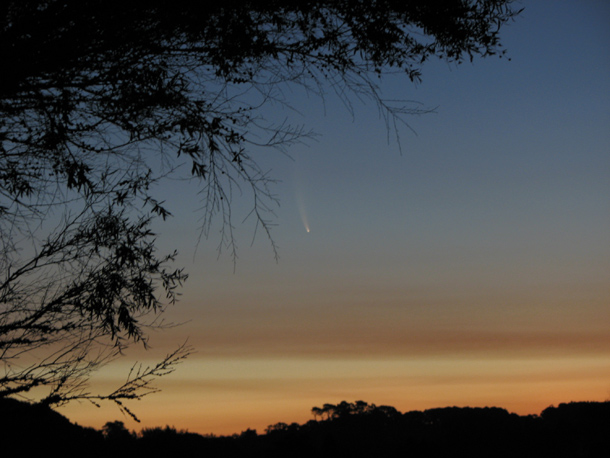 We normally think of comets as nighttime objects, visible only after the Sun sets. But if a comet gets close enough to the Earth, or close to the Sun at the right angle, it can become bright enough to be seen even during the day!
The image above is of Comet McNaught, an incredibly bright comet that graced our skies in 2006. I saw it myself in broad daylight; I stood so that my house blocked the Sun, and it was easily visible to my naked eye, far brighter than Venus and perhaps as bright as the Moon! It was incredible.
STEREO (a solar-observing pair of satellites) also took phenomenal images of McNaught. Astronomers usually look at faint objects, so we’re starved for photons. When a really bright comet comes along it’s nice to be able to actually see details, so daylight comets are more than just natural beauties. But they are amazingly gorgeous, and if one comes along again you can be sure I’ll raise the alarm.
Conclusion
One thing I didn’t write about in the main section, though I considered it, is that a lot of organic (carbon-based) compounds have been detected in comets. We know they hit the Earth, so it’s possible that a lot of the building blocks of life on Earth were actually brought here by comets. Given how many hit us, it’s also possible that a significant fraction of the water in our oceans came from ancient comet impacts as well! So even though a single impact could wipe us out, we wouldn’t be here without them.
There’s your profound thought for the day.
Credits:
All images are either licensed through creative commons, are in the public domain, or used by permission.
Introduction page: NASA, Mount Wilson and Las Campanas Observatories of the Carnegie Institution of Washington
# 1: Tamas Ladanyi
# 2: Nicole Gugliucci
# 3: Smithsonian National Air and Space Museum
# 4: NASA, ESA, H. Weaver (JHU/APL), M. Mutchler and Z. Levay (STScI)
# 5: ESO
# 6: Jen and Vic Winters of ICStars
# 7: Dreamworks
# 8: NASA/JPL-Caltech/UMD
# 9: SOHO (ESA & NASA)
# 10: Chris North
We normally think of comets as nighttime objects, visible only after the Sun sets. But if a comet gets close enough to the Earth, or close to the Sun at the right angle, it can become bright enough to be seen even during the day!
The image above is of Comet McNaught, an incredibly bright comet that graced our skies in 2006. I saw it myself in broad daylight; I stood so that my house blocked the Sun, and it was easily visible to my naked eye, far brighter than Venus and perhaps as bright as the Moon! It was incredible.
STEREO (a solar-observing pair of satellites) also took phenomenal images of McNaught. Astronomers usually look at faint objects, so we’re starved for photons. When a really bright comet comes along it’s nice to be able to actually see details, so daylight comets are more than just natural beauties. But they are amazingly gorgeous, and if one comes along again you can be sure I’ll raise the alarm.
Conclusion
One thing I didn’t write about in the main section, though I considered it, is that a lot of organic (carbon-based) compounds have been detected in comets. We know they hit the Earth, so it’s possible that a lot of the building blocks of life on Earth were actually brought here by comets. Given how many hit us, it’s also possible that a significant fraction of the water in our oceans came from ancient comet impacts as well! So even though a single impact could wipe us out, we wouldn’t be here without them.
There’s your profound thought for the day.
Credits:
All images are either licensed through creative commons, are in the public domain, or used by permission.
Introduction page: NASA, Mount Wilson and Las Campanas Observatories of the Carnegie Institution of Washington
# 1: Tamas Ladanyi
# 2: Nicole Gugliucci
# 3: Smithsonian National Air and Space Museum
# 4: NASA, ESA, H. Weaver (JHU/APL), M. Mutchler and Z. Levay (STScI)
# 5: ESO
# 6: Jen and Vic Winters of ICStars
# 7: Dreamworks
# 8: NASA/JPL-Caltech/UMD
# 9: SOHO (ESA & NASA)
# 10: Chris North
Ten Things You Don’t Know About Comets
Advertisement